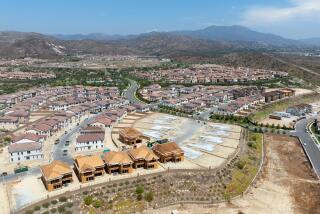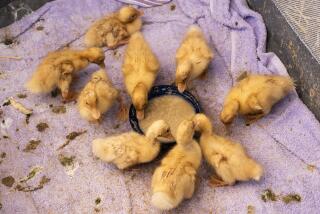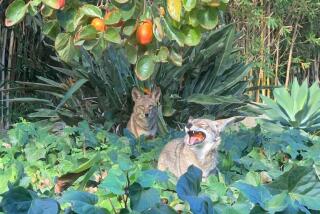Irvine’s San Joaquin Marsh Policy Is Strictly for the Birds
- Share via
Last fall, as migrating ducks landed in a lush and soggy marshland in Irvine on their annual trip south, they were often greeted by more than joggers and bicyclists enjoying the view. They were also met by a few duck hunters.
Duck hunting in Irvine may seem an anachronism, but ducks and hunters had been together in San Joaquin Marsh for decades, long before the wildlife preserve became surrounded by bicycle paths, carefully planned homes, office buildings and a university. The marsh--which is roughly bordered by Michelson Drive, MacArthur Boulevard, Carlson Avenue and the San Diego Creek Channel--is one of the last remaining duck hunting areas in fast-developing Southern California.
But this year, when the ducks make their rest stop in Irvine, there will be no hunters on the northern part of the marsh.
Although it was the hunters who through the years paid for the marsh’s upkeep, making it attractive to ducks, the Irvine City Council recently voted to take on that financial responsibility and withhold clearance for hunting in the northern marsh, which is owned by the Irvine Co.
The San Joaquin Gun Club has a long tradition of hunting in the marsh; it obtained its permit from the county before Irvine became a city in 1971. Its permit was routinely renewed by the city afterward, but club members apparently let the permit lapse accidentally in June, 1988. The lapse escaped notice until December, when the hunting season was nearly over.
City officials were reluctant to renew the permit after receiving telephone calls from concerned residents “hearing shotgun blasts and seeing birds fall out of the air,” one administrator said.
Prohibiting hunting carries a hefty price tag: If the gun club is not there, who is going to pay to keep the marshland flooded and maintained so birds and other wildlife will thrive in the preserve? Without a little human help, the preserve would dry out and turn into a barren wasteland.
“If we don’t do something now, it will be too late,” Irvine City Councilman Cameron Cosgrove said earlier this summer. He led the search for money.
“We will have thousands of migrating waterfowl and no habitat for them there,” he said, “and that will have a significant impact on the flyway population. They just won’t come back anymore, and that would be a big loss.”
Ron Young, general manager of the Irvine Ranch Water District, which maintains the northern marsh, agreed: “The birds fly from Canada to Mexico each year, and what they need are places to stay, food to eat. In these marshy areas, they have that, there’s water and food and vegetation, so they can hide from predators. If it’s dry, they won’t come. And then it gets wiped off their memory banks, so even if it is restored a few years from now, it’s too late.” Today, water is pouring into the northern marshland, as part of the $110,000, two-year allocation approved by the City Council earlier this summer. With that welcome mat, wildlife is expected to start arriving late this month.
The first year will cost the city $71,500, because extensive restoration was needed, including clearing some plants and shoring up dikes, in addition to the flooding.
Cosgrove has put together a committee of representatives of diverse groups with an interest in the wildlife preserve, to look into the long-term restoration and upkeep of the entire marsh, north and south ends.
“We wanted to take a more global approach,” Cosgrove said. Included in the group are representatives of the Audubon Society and the state coastal conservancy, which may provide some money, he said.
The Irvine Co. is expected to deed the northern marsh to the city in a few years, and it is charted to be part of the city’s open-space plan.
But the southern half is next to UC Irvine and belongs to the University of California. As on the Irvine Co. side, duck hunting has gone on for decades. However, the city’s decision not to allow the gun club back in the north may prompt UC officials to do the same.
Still, said Bill Bretz, steward of the UC marsh: “There’s no sound ecological reason to end the hunting, and there is a strong financial reason to have it continue.”
He said the Old San Joaquin Gun Club, which is permitted to hunt on the UC marsh, pays about $12,000 a year to flood the marsh.
Officials from the state Department of Fish and Game have agreed that the hunters have provided a valuable habitat, not only for ducks but also for other animals that live in the marsh and are part of its ecological balance.
Under state law, hunters in the marsh have been allowed to kill two ducks per day. Additionally, the gun clubs restricted their members to hunting three days a week and only during daylight hours. Hunters say they have always followed strict safety rules; no injuries caused by a hunter have been reported.
The hunters fire from deep within the marsh, far away from joggers and bicyclists along the perimeter. They have used shotguns, which discharge pellets that are generally not fatal to people at distances of more than 50 yards. At the UC reserve, hunters have shot about 100 ducks a season, which runs from about October through January.
Bretz said UC officials are deliberating the future of duck hunting in the UC reserve, to determine whether the city’s policy against hunting should be extended south, in the interest of being good neighbors.
What is left now for duck hunters? Harry Rinker, president of the San Joaquin Gun Club, which hunted on the city-controlled marshland, could not be reached for comment.
However, Councilman Cosgrove said all his discussions with the gun club president were amicable. Cosgrove said he told Rinker that the city will eventually be taking over the marshland and “that it wouldn’t be proper for hunting, and that it was probably best to phase it out immediately.”
He asked for the gun club’s help, to learn what needed to be done to restore the marsh, he said.
Although this spells the end of an era for the gun club, Rinker was cooperative, Cosgrove said: “He was not only willing to do it, but he was gracious about turning over information to us. They knew it was inevitable, that with growth, hunting was going to be phased out. They knew the time had come, and they graciously stepped aside.”
Cosgrove added: “This is a real success story. We can declare victory on saving the habitat and now focus on the long-term upkeep.”
More to Read
Sign up for The Wild
We’ll help you find the best places to hike, bike and run, as well as the perfect silent spots for meditation and yoga.
You may occasionally receive promotional content from the Los Angeles Times.






